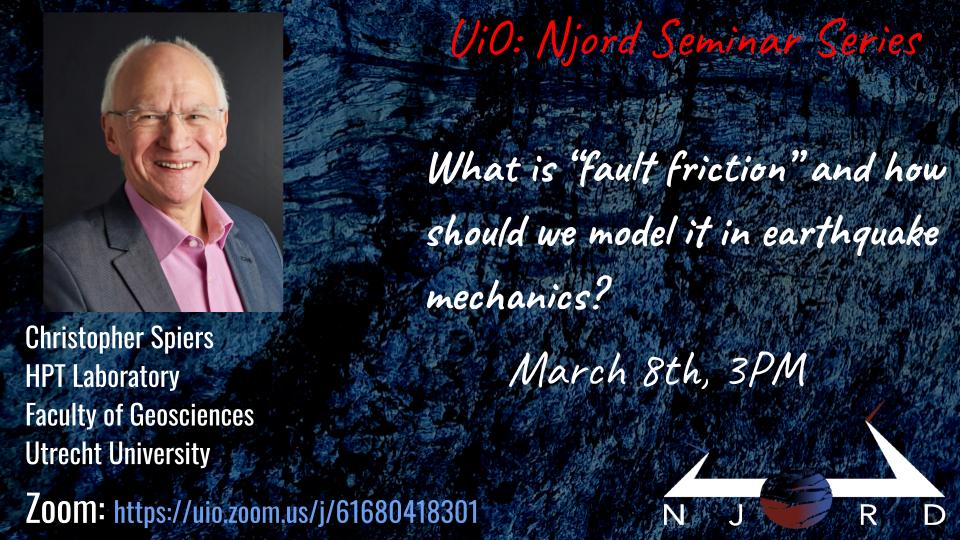Title of the talk: What is “fault friction” and how should we model it in earthquake mechanics?
Models describing the evolution of fault friction, during earthquake rupture nucleation and dynamic propagation, provide crucial input for computationally simulating both natural and induced earthquakes. But what is fault friction actually? Are classical laboratory models that describe the dependence of friction on interfacial sliding rate and interfacial state, applicable to the crushed and sheared rock materials that are found in natural faults? And do these classical models apply under the hot, wet, reactive and high pressure conditions that exist at seismogenic depths in the Earth’s crust? In this presentation, I shall trace the development of an alternative approach to understanding and modelling fault friction that is based on accounting for the micromechanical and chemical processes that are known to operate in rock materials under crustal conditions (following work by Niemeijer & Spiers 2007, Chen & Spiers 2016 and Chen, Niemeijer & Spiers, 2021, for example). The approach provides a unified route to understanding not only fault friction but also the transition from slow fault creep to unstable frictional failure and to subsequent fault healing, i.e. to understanding the full seismic cycle. I will describe the basic theoretical structure of the model and show how it predicts all of the effects of sliding velocity, temperature, normal stress, and pore fluid pressure on fault mechanical behaviour that are observed in experiments on fault rock materials conducted at surface to mid crustal conditions. In conclusion, I shall discuss the pros and cons of the model and touch on first attempts that are now being made to apply the model to seismic rupture modelling.
References:
Niemeijer, A. R., & Spiers, C. J. (2007). A microphysical model for strong velocity weakening in phyllosilicate-bearing fault gouges. Journal of Geophysical Research, 112, B10405. https://doi.org/10.1029/2007JB005008
Chen, J., & Spiers, C. J. (2016). Rate and state frictional and healing behavior of carbonate fault gouge explained using microphysical model. Journal of Geophysical Research: Solid Earth, 121, 8642–8665. https://doi.org/10.1002/2016JB013470
Chen, J., Niemeijer, A. R., & Spiers, C. J. (2021). Microphysical modeling of carbonate fault friction at slip rates spanning the full seismic cycle. Journal of Geophysical Research: Solid Earth, 126, e2020JB021024. https://doi.org/10.1029/2020JB021024
Short bio:
Chris Spiers is Emeritus Professor at the High Pressure-Temperature (HPT) Laboratory in the Geosciences Faculty at Utrecht University. He led the lab as Prof. of Earth Materials until 2020, specializing in experimental rock and fault mechanics and effects of fluid-rock interaction at upper crustal to upper mantle conditions. Chris gained his PhD from Imperial College, London (1976-1980). Following a Miller Fellowship at UC Berkeley (1980-81), he moved to Utrecht, where he built up the HPT Lab, receiving his chair in 1992. Chris has worked on topics from creep of crustal and upper mantle rock materials to seismic fault friction and to deformation and transport properties of reservoir rocks, caprocks, evaporites, coal and shales. Chris has served as Dean and Education Director in Earth Sciences at Utrecht and played a leading role in university and national research programmes on geo-resources, geo-storage and induced seismicity. He has published more than 220 peer-reviewed papers and book contributions and, in 2017, received the European Geosciences Union Néel Medal for his contribution to Rock Physics.
To get news, invitations to seminars and more from Njord, please go here to subscribe to our newsletter.
